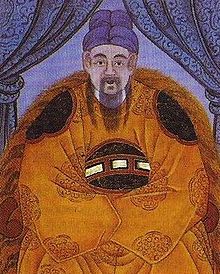King Gongmin of Goryeo
| Gongmin of Goryeo 고려 공민왕 |
|||||
|---|---|---|---|---|---|
 |
|||||
| King of Goryeo | |||||
| Reign | 1351 - 1374 | ||||
| Predecessor | Chungjeong of Goryeo | ||||
| Successor | U of Goryeo | ||||
| Born | 23 May 1330 | ||||
| Died | 27 October 1374 (aged 44) | ||||
| Burial | Hyeonjeongreung Royal Tomb | ||||
| Consort |
Queen Indeok Queen Sunjeong |
||||
| Issue | U of Goryeo | ||||
|
|||||
| House | House of Wang | ||||
| Father | Chungsuk of Goryeo | ||||
| Mother | Queen Gongwon | ||||
| Religion | Buddhism | ||||
| Posthumous name | |
|---|---|
| 인문의무용지명열경효대왕 仁文義武勇智明烈敬孝大王 |
| Gongmin of Goryeo | |
 |
|
| Hangul | |
|---|---|
| Hanja | |
| Revised Romanization | Gongmin wang |
| McCune–Reischauer | Kongmin wang |
| Pen name | |
| Hangul | also |
| Hanja | also |
| Revised Romanization | Ijae also Ikdang |
| McCune–Reischauer | Ijae also Iktang |
| Birth name | |
| Hangul | earlier |
| Hanja | earlier |
| Revised Romanization | Wang Jeon earlier Wang Gi |
| McCune–Reischauer | Wang Chŏn earlier Wang Ki |
| Sino-Korean Mongolian name | |
| Hangul | |
| Hanja | |
| Revised Romanization | Baegancheopmoga |
| McCune–Reischauer | Paegan Ch'ŏpmoga |
|
Monarchs of Korea Goryeo |
|---|
|
King Gongmin (23 May 1330 – 27 October 1374) ruled Goryeo Dynasty Korea from 1351 - 1374. He was the second son of King Chungsuk. In addition to his various Korean names, he bore the Mongolian name Bayan Temür (伯顔帖木兒).
Goryeo had been a semi-autonomous vassal state under the overlordship of the Mongol Yuan dynasty since the Mongol invasions of Korea in the 13th century. Starting with King Chungnyeol, prospective rulers of Korea married Mongolian princesses and were customarily sent to the Yuan Court, in effect, as hostages. As per this custom, King Gongmin spent many years in the Yuan court, being sent there in 1341, before ascending the Korean throne. He married a Mongolian princess who became Queen Noguk. The Yuan dynasty began to crumble during the mid-14th century, and was eventually conquered and replaced by the Ming dynasty in 1368.
With the disintegration of Yuan, which had influenced the Korean peninsula since the Mongol invasion of Korea of 1238, Gongmin began efforts to reform Goryeo government. His first act was to remove all pro-Mongol aristocrats and military officers from their positions. These deposed people formed a dissident faction which plotted an unsuccessful coup against the king. High official Jo Il-shin even tried to take over the government, but this rebellion was put down by general Choi Young.
During the Mongol invasions of Korea, between the 1250s and the 1270s, the Mongols had annexed the northern provinces of Korea and incorporated them into their empire as Ssangseong (쌍성총관부, 雙城總管府) and Dongnyeong Prefectures (동녕부, 東寧府). In 1356, the Goryeo army retook these provinces partly thanks to the defection of Yi Ja-chun, a minor Korean official in the service of the Mongols in Ssangseong, and his son, Yi Seong-gye. In addition, Generals Yi Seong-gye and Ji Yongsu led a campaign into Liaoyang.
...
Wikipedia
